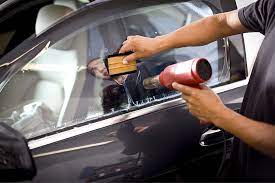Window tinting has become a popular choice for enhancing the aesthetics, comfort, and functionality of vehicles and buildings. By applying a thin film to glass surfaces, window tinting offers numerous advantages, from improved privacy to privacy window tint efficiency. This article explores the benefits of window tinting, different types of tints, and important considerations for making an informed decision.
What is Window Tinting?
Window tinting involves applying a specialized film to glass surfaces to reduce the amount of sunlight and heat entering a space. The film is typically made from a polyester base and can be coated with various materials to provide different levels of shading, reflectivity, and UV protection.
Benefits of Window Tinting
- UV Protection: One of the primary benefits of window tinting is its ability to block harmful ultraviolet (UV) rays. UV rays can cause skin damage, fading of interior furnishings, and deterioration of vehicle upholstery. High-quality window tints can block up to 99% of UV rays, protecting both occupants and interiors from sun-related damage.
- Heat Reduction: Window tinting helps reduce the amount of heat that enters through windows. By blocking a significant portion of infrared light, tinted windows can lower indoor temperatures, making spaces more comfortable and reducing the need for air conditioning. This can lead to energy savings and lower utility bills.
- Glare Reduction: Glare from the sun can be a major nuisance, especially while driving. Window tinting reduces glare, improving visibility and reducing eye strain. This is particularly beneficial for drivers who are sensitive to bright sunlight or who drive frequently during the day.
- Enhanced Privacy: Tinted windows provide an added layer of privacy by limiting the view from the outside. This is valuable for both residential and commercial properties, as it helps prevent prying eyes and enhances security by making it more difficult for others to see inside.
- Improved Aesthetics: Window tinting can enhance the appearance of vehicles and buildings by giving them a sleek, polished look. Available in various shades and finishes, window tints can complement the design and style of any property.
- Increased Safety: In the event of an accident, window tinting can help hold shattered glass together, reducing the risk of injury from flying glass shards. This added safety feature is particularly important for vehicle occupants.
Types of Window Tinting
- Dyed Window Tint: Dyed tints are made by applying a layer of dye between the adhesive layer and the polyester film. This type of tint provides good UV protection and heat reduction but may not be as effective as other types in blocking heat.
- Metalized Window Tint: Metalized tints incorporate tiny metallic particles in the film to reflect heat and UV rays. They offer excellent heat rejection and durability but may interfere with electronic signals such as GPS and cell phone reception.
- Ceramic Window Tint: Ceramic tints use advanced ceramic technology to provide superior heat rejection, UV protection, and clarity. They are highly effective, durable, and do not interfere with electronic signals. However, they are generally more expensive than other types of tints.
- Hybrid Window Tint: Hybrid tints combine elements of dyed and metalized films to offer a balance of heat rejection, UV protection, and aesthetic appeal. They are a good middle-ground option for those seeking both performance and affordability.
- Carbon Window Tint: Carbon tints use carbon particles to provide excellent heat rejection and a matte finish. They do not fade over time and offer good UV protection, making them a durable choice for both vehicles and buildings.
Considerations for Window Tinting
- Local Regulations: Before applying window tint, check local regulations regarding allowable tint levels and reflectivity. Laws regarding window tinting can vary by state or country, and it is important to ensure compliance to avoid fines and legal issues.
- Professional Installation: While DIY window tinting kits are available, professional installation is recommended for a high-quality finish and optimal performance. Professional installers have the experience and tools to ensure a perfect application without bubbles or imperfections.
- Warranty: Choose window tint films that come with a warranty to protect against defects, fading, and peeling. A good warranty provides peace of mind and ensures that any issues with the tint can be addressed by the manufacturer or installer.
- Maintenance: Proper maintenance is essential to keep tinted windows in good condition. Avoid using abrasive cleaners or tools that could damage the film. Regularly clean the tinted windows with a soft cloth and mild cleaning solution to preserve their appearance and functionality.
Conclusion
Window tinting offers a range of benefits, from improved UV protection and heat reduction to enhanced privacy and aesthetics. By choosing the right type of tint and considering important factors such as local regulations and professional installation, you can enjoy the advantages of window tinting for both your vehicle and property. Whether for comfort, safety, or style, window tinting is a practical investment that enhances the overall quality of your living or driving experience.
